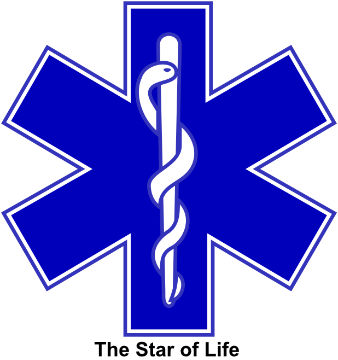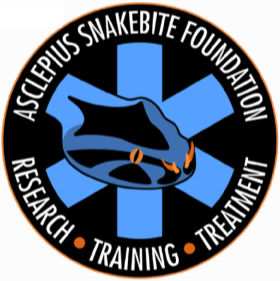As you may recall, in Part 1 of this two-part series, we took a quick look at venomous members of various segments of the animal kingdom, and laid out a brief argument as to why we should be cautious but not fearful around those creatures. After all, unlike Michael Myers or DOGE, they’re not really out to get you. But, you know, accidents do happen.
That being the case, let’s talk about what to do if you or your pet is envenomated, and we’ll focus on snake bites because those are the most common and troublesome events. There are some excellent online resources available to educate and assist victims, and for those who live where snake encounters aren’t unusual, they’re worth bookmarking.
I think it’s also important to consider some of the ways that venom is being used to better our lives. It’s a classic case of making lemonade out of lemons…or better yet, margaritas out of limes.

But first, a little history.
Early in the Biblical account of creation, an adversarial relationship between humans and serpents is divinely mandated. Thereafter, venomous snakes are employed by God as instruments of His judgment…but also as a mechanism for His grace. In the book of Numbers, there’s an account of how the Israelites rebelled against God and their leader Moses while traveling through the desert, and venomous snakes were sent as punishment for that act of disbelief. But when the people repented, God sent relief in the form of a carving of a snake on a pole, and anyone who simply looked at it after being bitten would be healed.
 Then there’s Asclepius, the god of medicine and medicinal arts in ancient Greek mythology. According to the preceding linked article, to the Greeks snakes were sacred beings of wisdom, healing, and resurrection. Ascelpius is often represented as wielding the Rod of Asclepius, a snake-entwined staff, which has been adapted into what is now known as the Star of Life, representing emergency medical services. We obviously don’t know what species of snake was represented in this symbol; some historians suggest that both harmless and venomous snakes were used in different ways for healing therapies.
Then there’s Asclepius, the god of medicine and medicinal arts in ancient Greek mythology. According to the preceding linked article, to the Greeks snakes were sacred beings of wisdom, healing, and resurrection. Ascelpius is often represented as wielding the Rod of Asclepius, a snake-entwined staff, which has been adapted into what is now known as the Star of Life, representing emergency medical services. We obviously don’t know what species of snake was represented in this symbol; some historians suggest that both harmless and venomous snakes were used in different ways for healing therapies.
The Rod of Ascelpius is sometimes confused with the Caduceus, which is a rod entwined with twice the number of snakes (i.e. two) and also sprouts a pair of wings at the top, and was used as a “magic wand” by the messenger of the gods (Hermes if you’re in Athens; Mercury whilst in Rome). Please don’t embarrass yourself by getting them mixed up.
You’re probably wondering why I’ve burned through so many pixels to explain the significance of Ascelpius, who, as far as I know, isn’t famous enough to warrant a character on The Simpsons. Well, it’s just a convoluted introduction to an organization called the Asclepius Snakebite Foundation (ASF). The ASF is a non-profit organization dedicated to helping victims of snakebite around the world. It’s a relatively young organization, established in 2018 as a joint effort between herpetologists and medical professionals. In addition to providing treatment for bite victims, it offers training on proper snakebite management to healthcare providers, and engages in research to better understand associations between venom composition and snakebite syndromes, which in turn can lead to better outcomes for patients.
Well, it’s just a convoluted introduction to an organization called the Asclepius Snakebite Foundation (ASF). The ASF is a non-profit organization dedicated to helping victims of snakebite around the world. It’s a relatively young organization, established in 2018 as a joint effort between herpetologists and medical professionals. In addition to providing treatment for bite victims, it offers training on proper snakebite management to healthcare providers, and engages in research to better understand associations between venom composition and snakebite syndromes, which in turn can lead to better outcomes for patients.
Most of the ASF’s on-the-ground work is focused in rural areas in Africa, where tens of thousands of people are envenomated every year, thousands die from inadequate or inappropriate care, and thousands more suffer amputations or other disabilities. Its work is serving to significantly reduce fatalities and morbidities where its clinics are located.
But snake envenomation isn’t confined to remote areas of Africa. The CDC estimates that up to 8,000 people are bitten by venomous snakes in the US each year (but in contrast with Africa, they result in only about five fatalities). However, many more of those people suffer from some sort of disability, short- or long-term.
In addition, as many as 150,000 dogs and cats in the US are envenomated each year, and as many as 20% of those bites result in death for dogs, even with prompt care. That statistic is not available for cats in the US, although a study in Australia found that cats are twice as likely to survive; the reasons for this are hypothetical, including the suspicion that cats possess a form of dark magic. (I just made that up. But, still…)
Unfortunately, not every doctor or veterinarian is an expert in dealing with venomous snake bites, which is not surprising given the relative rarity of cases, especially for humans. So it’s important that everyone living in areas where one or more of the 30 species of venomous snakes in the US could be encountered — which is everyone except residents of Hawaii, Alaska, Rhode Island, and Maine (those states have their own issues, namely volcanoes, grizzly bears, Pauly D, and Stephen King, respectively) — need to be able to advocate for themselves, their dependents, and their pets.
But, you may be asking, where could I find information that would allow me to do that? I’m so glad you asked. There is a 501(c)(3) organization called National Snakebite Support (NSS) which should be your primary source for information regarding the treatment of envenomation of people and pets. It’s staffed by medical and veterinary experts, researchers, and herpetologists, and it provides up-to-date, easy-to-use protocols for both humans and non-humans.
For people who have been bitten, there are two protocols to observe:
- Pre-hospital snakebite management (PDF document): what to do before you can get to a hospital
- In-hospital snakebite management (PDF document): steps your doctor should be taking to treat you
Similar protocols are available for pet owners:
- Pre-hospital snakebite management (PDF document): what to do for your pet before you can get them to a veterinary clinic or hospital
- Snakebite management/treatment for veterinarians (PDF document): steps your vet should take (and some that should NOT be taken) to treat your pet
One of the most important proactive steps you can take on behalf of your pet is to locate the closest vet clinic that stocks antivenom. Antivenom is the only method of neutralizing the toxicity of venom; all other recommended treatments are for the relief of symptoms, but they don’t address the underlying cause. The NSS website has a locator map showing vet clinics that stock antivenom, but it’s admittedly not comprehensive. Your best course of action is to call your local clinic(s) and ask about the availability of antivenom.
The NSS website also has some great educational material, including a page that debunks certain myths (e.g. vaccinations against snakebites for dogs are effective and recommended; mothballs will repel snakes; benedryl is effective in treating snakebites; etc.).
All of the preceding resources are terrifically helpful, but the real strength of NSS is in its Facebook Group where snakebite victims or pet owners can request and receive almost real-time advice from the expert volunteers who constantly monitor the group. It’s impossible to overstate the value of joining this group.

I mentioned antivenom (aka antivenin) above, and this might be a good time to briefly discuss the types that are commonly used.
First, there are two general types of venom…or, more to the point, two general ways that venom affects the body. The first (and most common in snakes found in the US) is hemotoxic. Hemotoxins work on the blood stream, destroying red blood cells and causing tissue damage and internal bleeding, among a number of other unwelcome effects. In the US, snakes with primarily hemotoxic venom include rattlesnakes, cottonmouths (aka water moccasins), and copperheads.
The second type of venom is neurotoxic, meaning that it affects the nervous system. The most serious effect is the paralysis of skeletal muscles that control the respiratory system, so that the victim suffocates. The only species of snake in the US that has primarily neurotoxic venom is the coral snake.
Notice that I was careful to use the term primarily when characterizing a snake’s venom. Venom is composed of a complex mixture of proteins and peptides (strings of amino acids) and this toxic cocktail doesn’t necessarily adhere to a strict set of effects on the body of victims. In other words, snake venom is often a combination of hemotoxic and neurotoxic components, although one or the other is usually dominant. Here’s an excellent article that explains why this is the case. I especially like this:
Snakes with a mixture of venom types can cause significant tissue damage and also paralytic effects such as numbness, drooping eyelids, etc. This is why we must use different anti-venoms in medicine to counter the effects of the different venoms of different species of snakes.
Ecologically speaking, the ends of this venom continuum tend to specialize on endothermic prey (hemotoxins) versus ectothermic prey (neurotoxins). This is because the physiology of an endothermic animal is very sensitive to sudden drop in blood pressure. Hence, a venom that will rapidly drop blood pressure will very quickly disable and kill a mouse or bird. Ectotherms, like fish, amphibians, or snakes and lizards, are not nearly so sensitive and can tolerate huge swings in blood pressure, so neurotoxins simply disable them through muscular paralysis. These differences are evident in the diets of the snakes. A snake-specialist cobra typically will have a high proportion of neurotoxins, and a mammal-specialist rattlesnake may be primarily hemotoxic. A generalist predator like a cottonmouth (Agistrodon piscivorus) has mixture of both types of venoms.
The author goes on to explain that in some species, the venom components — or at least the proportions of the components — change as the animal ages, apparently due in some cases to the natural change in prey (from, say, ectothermic lizards to endothermic rabbits…cold-blooded to warm-blooded). I find that to be a fascinating phenomenon.
As an aside, did you notice the reference to snake-specialist cobra in the preceding quote? That doesn’t imply that cobras are herpetologists — hardly any of them advance between kindergarten [OK, I made that up, too] — it means that they are ophiophagous…i.e. they eat other snakes. Coral snakes fall into this category as well.
We’ll discuss antivenom in more detail later.

We’ve now covered some rather esoteric topics about venom and specifically snake venom, and some practical topics, including what to do if you or your pet is bitten by a venomous snake. Most of these topics fall into the arbitrary and unwieldy category of “bad things associated with venom.” But it’s not all bad news in the wonderful world of venom; a lot of really great developments have emerged as scientists study and learn more about the molecular makeup of venoms from various creatures. Some of these developments have the potential to be life-changing, and a few are literally life-saving. Ironic, huh?
Components of venom have two characteristics that make them excellent candidates for medicinal use: they’re fast acting, and they typically can be stored for long periods of time. Following are a handful of examples of how synthesized components of venom are being used to treat human health-related issues.
- Gila monster venom contains a molecule caled exendin-4. It became the basis for a drug called, creatively enough, Exenatide which is used to treat type 2 diabetes. Users of this drug discovered that they also lost weight, and this discovery then led to development of drugs such as Ozempic, Wegovey, etc.*
- Peptides in the venom of a Brazilian viper known as a jararaca (Bothrops jararaca) became the basis for the first ACE inhibitor, captopril, that treats hypertension.*
- There’s a peptide in scorpion venom that binds to malignant tumors (including those in the brain), and when it’s engineered to be fluorescent, surgeons can determine whether they’ve successfully removed the entire tumor.*
- The potentially deadly venom of some species of cone snails contains peptides that can block pain receptors in the human spine. One of them was used in the development of an analgesic, ziconotide, which is used to treat patients suffering from chronic pain.*
- Hi1a is a molecule discovered in the venom of the K’gari funnel web spider, which is native to Australia, and whose venom is possibly the most toxic of any spider on earth. Hi1a is currently in preclinical trials as a drug that may prevent cardiac damage caused by heart attacks or strokes.
- The venom of another Australian funnel web spider (Hadronyche versuta) provides the basis for a biopesticide manufactured and sold by a company called Vestaron to protect crops from destructive insects such as grasshoppers and some beetles. Vestaron has solved the challenge of synthesizing the active ingredients, thereby bypassing the non-commercially viable alternative of milking spiders to get the venom. (As an aside, the absence of “spider milker” from a list of the World’s Worst Jobs seems to be an inexplicable and egregious oversight.)
These are just a few of the uses of components of venom, and there are myriad studies underway that could result in other health-related breakthroughs.

Of course, the most common use of venom is the development of antivenom…in effect, weaponizing it against itself. This effort has produced two distinct antivenoms for bites by venomous snakes which are native to North America.
CroFab — short for Crotalidae Polyvalent Immune Fab — is a frequently used and the oldest (approved in 2000 by the FDA) antivenom in current use that’s effective in neutralizing the effects of bites to humans from rattlesnakes, copperheads, and cottonmouths, all of which are pit vipers (they use heat-sensing organs to detect their prey) and members of the Crotalinae subfamily. All species in that group have venom that’s primarily hemotoxic.
In 2018 a new antivenom — Anavip — was approved for use in rattlesnake bites; two years later it was approved for treatment of cottonmouth envenomations. And, finally, in 2021 it was approved for bites from copperheads.
According to this study, CroFab requires fewer vials for initial treatment and thus may be less expensive, but Anavip may be a bit more effective in terms of reducing certain longer-term complications. (The study excluded bites from cottonmouths due to lack of significant data.) But both are considered to be quite effective, and there’s no real value in going out of one’s way to get one instead of the other. IOW, the best antivenom is whichever one you can get the quickest. As snakebite specialists are fond of saying, time is tissue when it comes to pit viper bites.
It is worth noting, however, that in cases where the patient suffered nervous system issues, CroFab seems to be somewhat more effective. As you may recall, even though pit viper venom is primarily hemotoxic, in some species it does have some neurotoxic components.
Both CroFab and Anavip are concocted with antibodies derived from sheep. Occasionally, a snakebite victim may be treated with both antivenoms, due either to initial “treatment failure” (rare), or subsequent transfer to another facility that stocked the other product.
There are three species of coral snake native to the US: the eastern coral snake (Micrurus fulviu), the Texas coral snake (Micrurus tener), and the Sonoran or Arizona coral snake (Micruroides euryxanthus). Their venom is primarily neurotoxic. The antivenom that’s most commonly prescribed to treat their bites is called North American Coral Snake Antivenin (NACSA), produced by Pfizer. It is derived from antibodies produced by horses.
Antivenom options for dogs and cats are also varied, but a discussion of the details is beyond the scope of this post. Again, my advice is to check with your local veterinarian to see if they stock antivenom, and if not, ask them for the location of the nearest emergency vet clinic that is equipped to treat snakebites.

If you’ve managed to make it this far, you have my admiration. This topic is admittedly not for everyone, but I hope it was helpful in underscoring the amazing diversity and complexity of a natural phenomenon that potentially affects all of us.
And if you’re more expert or experienced than me in the fields of venomology or toxicology, and you spot factual errors or errors in interpretation, I’d love to hear from you. Please feel free to leave your feedback in the comment section below.
As for everyone else, I think we’ll return to our usual fare of cat- and dog-related memes pretty soon.

*These examples were extracted from an article in the New York Times Magazine entitled Nature’s ‘Swiss Army Knife’: What Can We Learn From Venom?, dated November 13, 2024 and authored by Kim Tingley. The article may be behind a paywall. [return]
Discover more from The Fire Ant Gazette
Subscribe to get the latest posts sent to your email.

